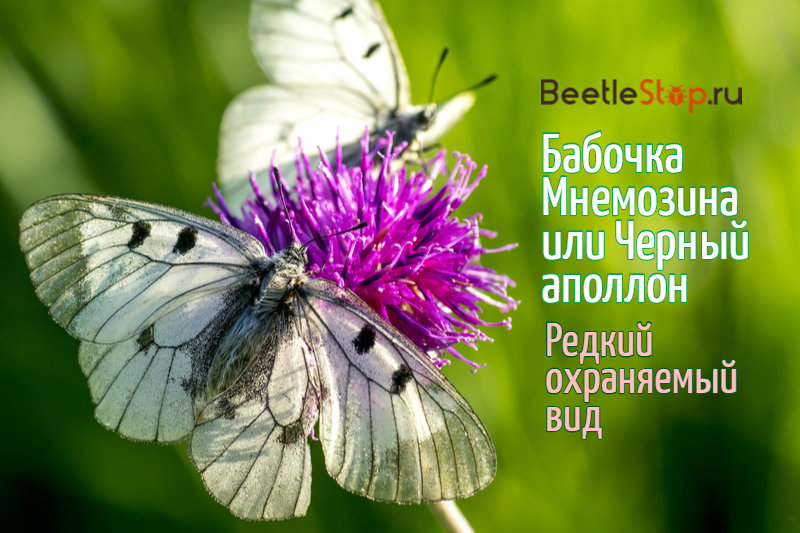Mnemosyne butterfly - an insect from the Red Book
Mnemozin’s butterfly looks very similar to a malicious garden pest - cabbage whitefish, and female. If you do not look closely, you can easily confuse them, although even biologically they belong to different families.
The Red Book inhabitant, unlike a cabbage lover, does not have such an intense coloring of the tips of the front wings. On the contrary, the color is completely absent in these places, and the wing is as if glassy, which is clearly visible in the photo of the Mnemosyne butterfly.

Biological Characterization and Description
Classification
Mnemosyne belongs to the genus Parnassius from the family Sailboats. This day butterfly is named after the heroine of ancient Greek mythology - the goddess of memory, the daughter of Uranus and Gaia. In turn, the mythological Mnemosyne was considered the mother of nine muses.
The butterfly has another name - "Black Apollo." She received this name for similarity with another insect of this genus - the butterfly Apollo, which differs from it by the absence of yellow spots.
Appearance
The wingspan of the black Apollo is about seventy millimeters with a front wing length of two and a half centimeters. The body and short antennae are painted in a dark, almost black color.
The color of the mnemosyne butterfly is not bright, the main background of the wings is white, on the front there are two black dots, and their edges are completely transparent. A black border is available near the anal area.
Mnemosinos has a slightly pronounced sexual dimorphism, females have a slightly larger light strip and are colored a bit more intense than males.
It is interesting! Also, females, if we apply the human definition, are more skaters and have a hint of a waist, which is not observed in males.
The description of the mnemosyne butterfly ends with a mention of the presence of many black veins neatly distributed over the surface of the wings.
Spread
Black Apollos are quite widespread: they live in continental Europe, in Asia, including in Western Siberia. From the north, the habitat reaches the Arkhangelsk region, from the south it is limited to Afghanistan, Syria, and Southern Altai.
Mnemosyne settles along the banks of rivers and streams, along the edges of forests and open glades among shrubs. Basically black apollo fly in places where their feed plants are present: corydalis are hollow and dense.
Attention! In altitude, butterflies mnemosyns are quite flexible, able to rise up to 1600 meters above sea level.
It should be noted that butterflies of this species lead a sedentary lifestyle and rarely fly away from a chosen place, unless some kind of environmental disaster occurs.
Reproduction and lifestyle
The mnemosyne butterfly has a rather interesting way of life, for example, a fully formed caterpillar hibernates in an insect, but does not hatch from an egg. With spring warming in nature, in April-May, depending on the region, the larvae emerge from the eggs and begin to feed on the leaves of the Corydalis.
Our help! Adult butterflies also by and large eat corydalis, sucking nectar from their flowers.
The appearance of the caterpillars is quite bright: a black body with bright yellow spots. These marks are located in two parallel lines along the body of the larva.
It is interesting! If the mnemosin butterflies lead an exclusively daily life, then the caterpillars go out to eat only at night. They wait for daylight hours, buried in the litter of leaves.
Having gained sufficient size and weight, the caterpillar of the black Apollo pupates, settling for the duration of this stage under the litter. In a dense cocoon on the soil, transformation into an imago occurs.
Butterflies fly out approximately at the beginning of July with a shift of a couple of weeks in both directions. After mating, another feature of this species is manifested, in the female, the genital tract is sealed with a protein stopper. So nature protected her from repeated fertilization by another male.
After some time, the female black apollo lays about forty testicles on the underside of the leaves of the Corydalis. The development of caterpillars lasts almost until the onset of stable colds, after which the insect enters the stage of suspended animation until spring.
Limiting factors and insect protection
The decrease in the mnemosin butterfly population is directly related to human activity. We note such human factors:
- deforestation;
- flooding of meadows and fields;
- Forest fires;
- plowing of land.
All of the above leads to the destruction of the food supply of butterflies, and with it the decrease in the number of mnemosines themselves.
As a rare endangered species, the black Apollo is included in the Red Books of the Scandinavian countries, Slovakia, and Poland. Many regions of Russia also included the butterfly mnemosyne in their documents protecting nature.
Interesting Facts
There are several noteworthy facts related to mnemosyne butterflies:
- The writer Vladimir Nabokov, one of whose hobbies was collecting butterflies, devoted poetry to the Black Apollo.
- In some countries, it is believed that if you see three mnemosin butterflies at the same time, some happy event will soon happen.
- Corydalis plants are also taken under protection as a food item mnemosyne.
At the end of the conversation, we suggest you watch a video about the mnemosin butterfly.

